check engine YAMAHA GRIZZLY 700 2016 User Guide
[x] Cancel search | Manufacturer: YAMAHA, Model Year: 2016, Model line: GRIZZLY 700, Model: YAMAHA GRIZZLY 700 2016Pages: 176, PDF Size: 4.47 MB
Page 66 of 176

6-1
6
EBU19882
OPERATION
EBU19902Read the Owner’s Manual carefully before riding
the ATV. If there is a control or function you do not
understand, ask your Yamaha dealer.
WARNING
EWB00632Read the Owner’s Manual carefully to become
familiar with all controls in order to help pre-
vent any loss of control, which could cause an
accident or injury. EBU30561Starting the engineNOTICEECB00151See the “Engine break-in” section on page 6-4
prior to operating the engine for the first time. 1. Turn the key to “ ” (on) and the engine stopswitch to “ ”.
The following warning lights should come on
for a few seconds, then go off.
Coolant temperature warning light
Engine trouble warning light
The EPS warning light should come on, then
go off when the engine is started. (for EPS
model)
NOTICEECB00825If a warning light does not go off, see page 4-2
for the corresponding warning light circuit
check. To avoid possible damage, do not oper-
ate the ATV if a warning light stays on. 2. Apply the brake pedal, and then shift the drive select lever into the neutral or park position.
The corresponding indicator light should
come on. If the indicator light does not come
on, have a Yamaha dealer check the electrical
circuit.TIPThis model is equipped with an ignition circuit cut-
off system. The engine can be started under the
following conditions:
The drive select lever is in the neutral or park po-
sition.
U2UD60E0.book Page 1 Tuesday, April 28, 2015 11:55 AM
Page 69 of 176
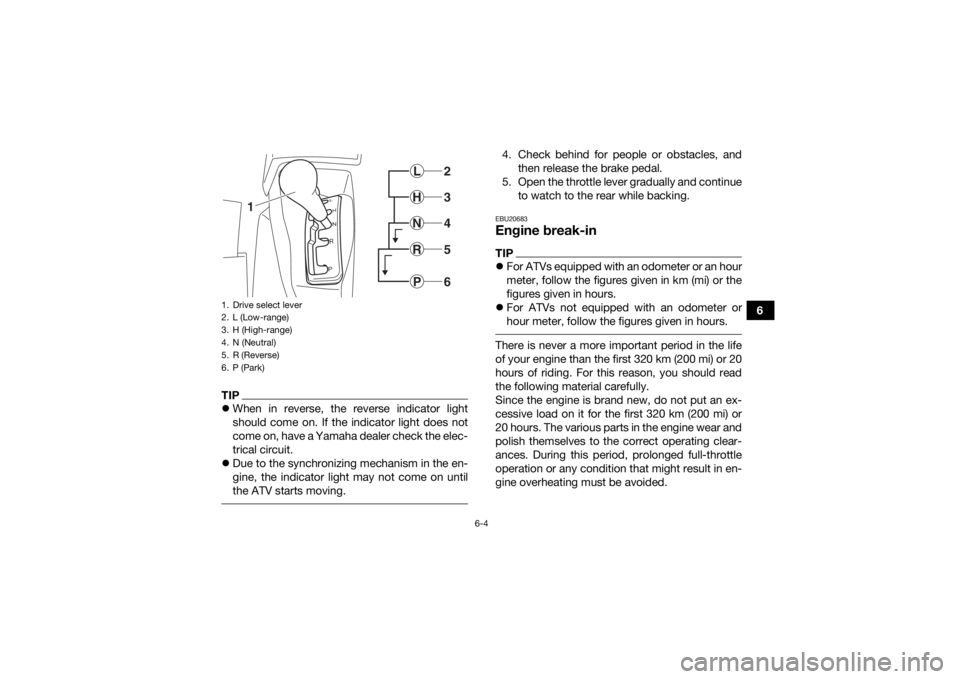
6-4
6
TIPWhen in reverse, the reverse indicator light
should come on. If the indicator light does not
come on, have a Yamaha dealer check the elec-
trical circuit.
Due to the synchronizing mechanism in the en-
gine, the indicator light may not come on until
the ATV starts moving.
4. Check behind for people or obstacles, and
then release the brake pedal.
5. Open the throttle lever gradually and continue to watch to the rear while backing.EBU20683Engine break-inTIPFor ATVs equipped with an odometer or an hour
meter, follow the figures given in km (mi) or the
figures given in hours.
For ATVs not equipped with an odometer or
hour meter, follow the figures given in hours. There is never a more important period in the life
of your engine than the first 320 km (200 mi) or 20
hours of riding. For this reason, you should read
the following material carefully.
Since the engine is brand new, do not put an ex-
cessive load on it for the first 320 km (200 mi) or
20 hours. The various parts in the engine wear and
polish themselves to the correct operating clear-
ances. During this period, prolonged full-throttle
operation or any condition that might result in en-
gine overheating must be avoided.
1. Drive select lever
2. L (Low-range)
3. H (High-range)
4. N (Neutral)
5. R (Reverse)
6. P (Park)
1
23456
LHNRP
U2UD60E0.book Page 4 Tuesday, April 28, 2015 11:55 AM
Page 70 of 176
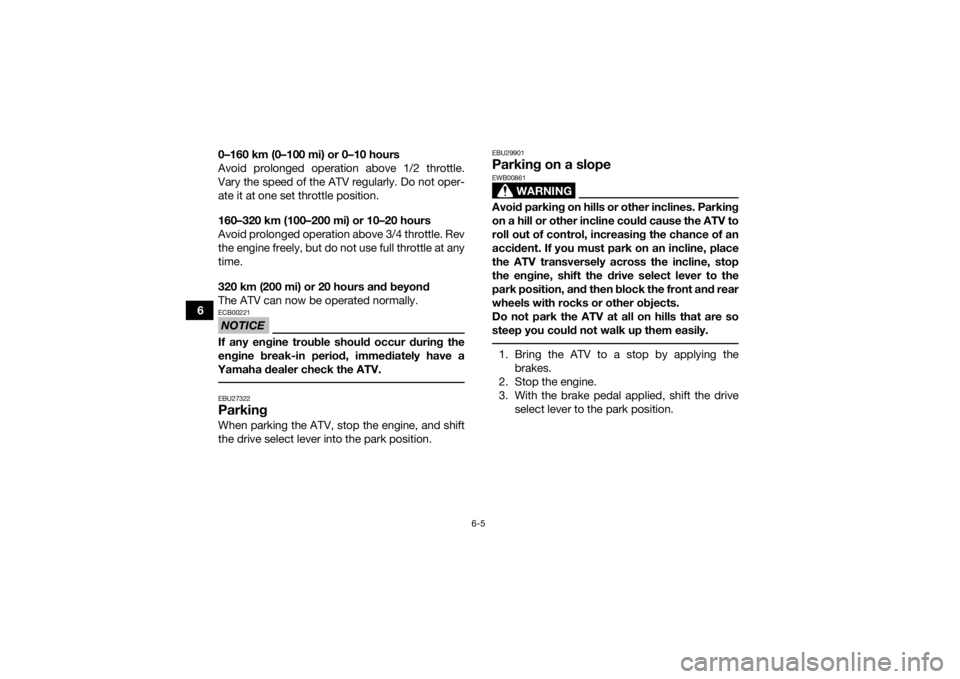
6-5
60–160 km (0–100 mi) or 0–10 hours
Avoid prolonged operation above 1/2 throttle.
Vary the speed of the ATV regularly. Do not oper-
ate it at one set throttle position.
160–320 km (100–200 mi) or 10–20 hours
Avoid prolonged operation above 3/4 throttle. Rev
the engine freely, but do not use full throttle at any
time.
320 km (200 mi) or 20 hours and beyond
The ATV can now be operated normally.
NOTICEECB00221If any engine trouble should occur during the
engine break-in period, immediately have a
Yamaha dealer check the ATV. EBU27322ParkingWhen parking the ATV, stop the engine, and shift
the drive select lever into the park position.
EBU29901Parking on a slope
WARNING
EWB00861Avoid parking on hills or other inclines. Parking
on a hill or other incline could cause the ATV to
roll out of control, increasing the chance of an
accident. If you must park on an incline, place
the ATV transversely across the incline, stop
the engine, shift the drive select lever to the
park position, and then block the front and rear
wheels with rocks or other objects.
Do not park the ATV at all on hills that are so
steep you could not walk up them easily. 1. Bring the ATV to a stop by applying the brakes.
2. Stop the engine.
3. With the brake pedal applied, shift the drive select lever to the park position.
U2UD60E0.book Page 5 Tuesday, April 28, 2015 11:55 AM
Page 82 of 176
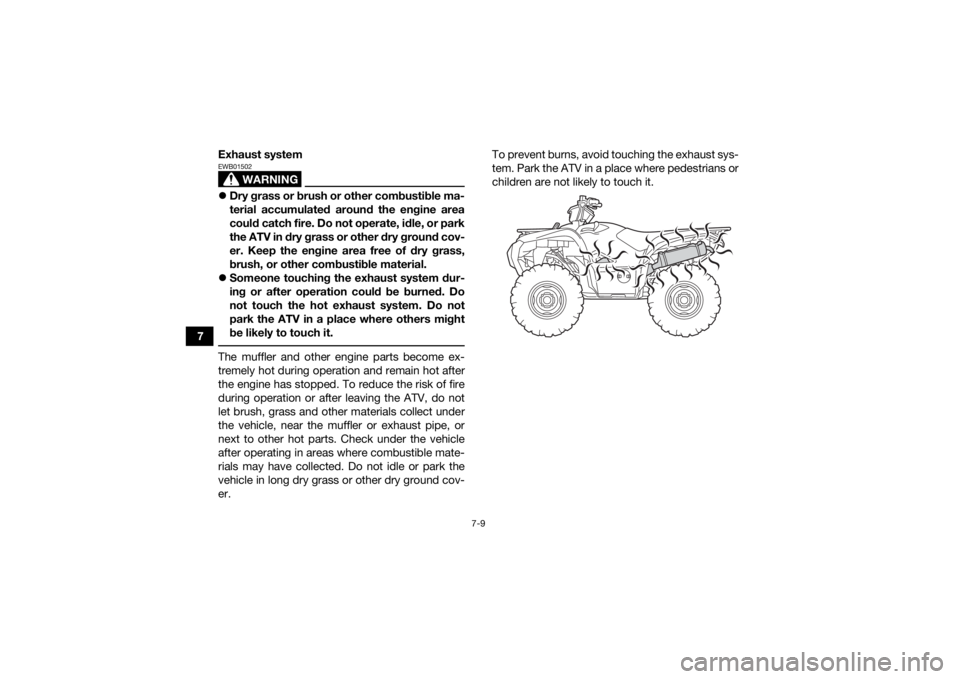
7-9
7Exhaust system
WARNING
EWB01502
Dry grass or brush or other combustible ma-
terial accumulated around the engine area
could catch fire. Do not operate, idle, or park
the ATV in dry grass or other dry ground cov-
er. Keep the engine area free of dry grass,
brush, or other combustible material.
Someone touching the exhaust system dur-
ing or after operation could be burned. Do
not touch the hot exhaust system. Do not
park the ATV in a place where others might
be likely to touch it. The muffler and other engine parts become ex-
tremely hot during operation and remain hot after
the engine has stopped. To reduce the risk of fire
during operation or after leaving the ATV, do not
let brush, grass and other materials collect under
the vehicle, near the muffler or exhaust pipe, or
next to other hot parts. Check under the vehicle
after operating in areas where combustible mate-
rials may have collected. Do not idle or park the
vehicle in long dry grass or other dry ground cov-
er. To prevent burns, avoid touching the exhaust sys-
tem. Park the ATV in a place where pedestrians or
children are not likely to touch it.U2UD60E0.book Page 9 Tuesday, April 28, 2015 11:55 AM
Page 90 of 176

7-17
7
Always check the terrain carefully before you
start down any hill.
Never operate the ATV on hills too steep for
the ATV or for your abilities. The ATV can
overturn more easily on extremely steep hills
than on level surfaces or small hills.
Shift your weight backward and to the up
side of the hill.
Never go down a hill at high speed.
Avoid going down a hill at an angle that
would cause the ATV to lean sharply to one
side. Go straight down the hill where possi-
ble.
Improper braking can cause the wheels on
the uphill side to come off the ground or
cause loss of traction. Apply brakes gradual-
ly. If in “2WD”, apply only the rear brake.
When riding your ATV downhill, shift your weight
as far to the rear and uphill side of the ATV as pos-
sible. Move back on the seat and sit with your
arms straight. Engine compression will do most of
the braking for you. For maximum engine com-
pression braking effect, select the low-range posi-
tion and change to “4WD” before beginning to
descend the hill. Use caution while descending a hill with loose or
slippery surfaces. Braking ability and traction may
be adversely affected by these surfaces. Improper
braking may also cause a loss of traction.
When this ATV is in “4WD”, all wheels (front and
rear) are interconnected by the drive train. This
means that applying either the front brake or the
rear brake will brake all wheels. When descending
hills, using either brake lever or the brake pedal
will brake the wheels on the downhill side. Avoid
sudden application of either the front or rear brake
because the wheels on the uphill side could come
off the ground. Apply both the front and rear
brakes gradually.
Whenever possible, ride your ATV straight down-
hill. Avoid sharp angles which could allow the ATV
to tip or roll over. Carefully choose your path and
ride no faster than you will be able to react to ob-
stacles which may appear.U2UD60E0.book Page 17 Tuesday, April 28, 2015 11:55 AM
Page 104 of 176

8-7
8
11*Shock absorber as-
semblies • Check operation and correct if necessary.
• Check for oil leakage and replace if necessary.
√√√
12 *Stabilizer bushes • Check for cracks or other damage, and replace if
necessary. √√√
13 *Rear knuckle pivots • Lubricate with lithium-soap-based grease. √√√
14 *Steering shaft • Lubricate with lithium-soap-based grease. √√√
15 *Steering system • Check operation and repair or replace if dam-
aged.
• Check toe-in and adjust if necessary. √√√√√
16 *Engine mount • Check for cracks or other damage, and replace if
necessary. √√√
17 *Axle boots • Check for cracks or other damage, and replace if
necessary. √√√√√
18 Engine oil • Change.
• Check ATV for oil leakage, and correct if neces-
sary. √ √√√
19 Engine oil filter car-
tridge • Replace.
√√√
20 Differential gear oil • Change.
• Check ATV for oil leakage, and correct if neces-
sary. √√
NO. ITEM
CHECK OR MAINTENANCE
JOB INITIAL EVERY
Whichev-
er comes first month136612
km (mi) 320
(200) 1300
(800) 2500
(1600) 2500
(1600) 5000
(3200)
hours 20 80 160 160 320U2UD60E0.book Page 7 Tuesday, April 28, 2015 11:55 AM
Page 115 of 176

8-18
8
EBU34190Checking the spark plugThe spark plug is an important engine component,
which is easy to check. Since heat and deposits
will cause any spark plug to slowly erode, the
spark plug should be removed and checked in ac-
cordance with the periodic maintenance and lubri-
cation chart. In addition, the condition of the spark
plug can reveal the condition of the engine.
To remove the spark plug1. Remove panels A and C. (See page 8-10.)
2. Remove the storage compartment by remov- ing the bolt. 3. Remove the spark plug cap.
Tightening torques:
Panel bolt:4.0 Nm (0.40 m·kgf, 2.9 ft·lbf)
Footboard nut: 4.0 Nm (0.40 m·kgf, 2.9 ft·lbf)
1. Storage compartment
2. Bolt
1. Spark plug cap2 1
1
U2UD60E0.book Page 18 Tuesday, April 28, 2015 11:55 AM
Page 116 of 176
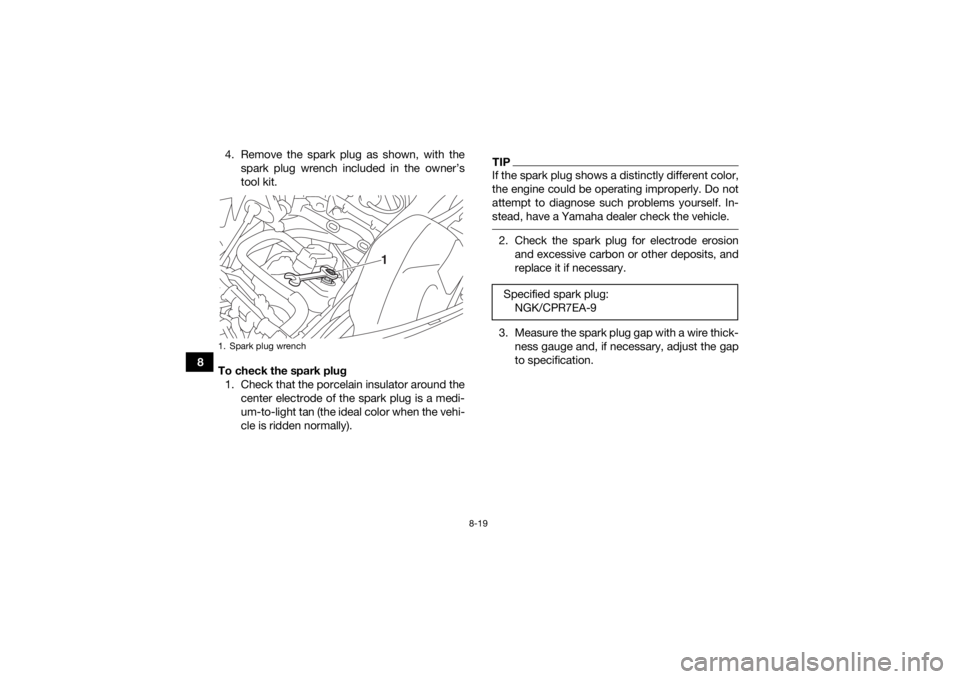
8-19
84. Remove the spark plug as shown, with the
spark plug wrench included in the owner’s
tool kit.
To check the spark plug 1. Check that the porcelain insulator around the center electrode of the spark plug is a medi-
um-to-light tan (the ideal color when the vehi-
cle is ridden normally).
TIPIf the spark plug shows a distinctly different color,
the engine could be operating improperly. Do not
attempt to diagnose such problems yourself. In-
stead, have a Yamaha dealer check the vehicle. 2. Check the spark plug for electrode erosionand excessive carbon or other deposits, and
replace it if necessary.
3. Measure the spark plug gap with a wire thick- ness gauge and, if necessary, adjust the gap
to specification.
1. Spark plug wrench
1
Specified spark plug:NGK/CPR7EA-9
U2UD60E0.book Page 19 Tuesday, April 28, 2015 11:55 AM
Page 118 of 176

8-21
8
EBU27469Engine oil and oil filter cartridgeThe engine oil level should be checked before
each ride. In addition, the oil must be changed and
the oil filter cartridge replaced at the intervals
specified in the periodic maintenance and lubrica-
tion chart.
To check the engine oil level1. Place the ATV on a level surface.
2. Check the engine oil level on a cold engine.TIPIf the engine was started before checking the oil
level, be sure to warm up the engine sufficiently,
and then wait at least 10 minutes until the oil set-
tles for an accurate reading. 3. Remove the access cover by turning it coun- terclockwise. 4. Remove the engine oil dipstick, and then
wipe it off with a clean rag.
1. Access cover
1. Engine oil dipstick
1
U2UD60E0.book Page 21 Tuesday, April 28, 2015 11:55 AM
Page 119 of 176
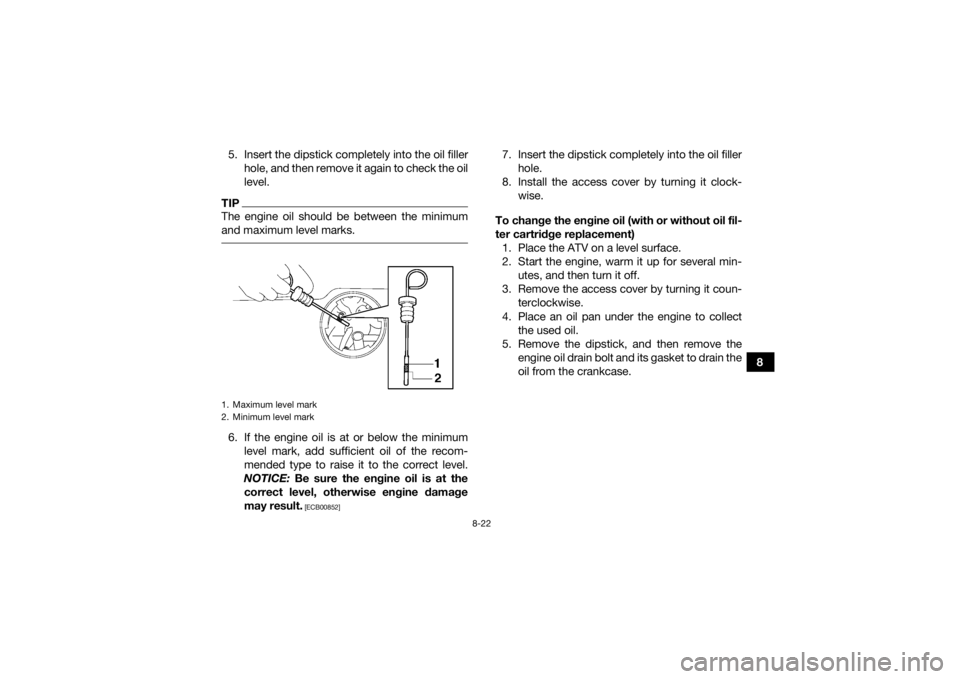
8-22
8
5. Insert the dipstick completely into the oil filler
hole, and then remove it again to check the oil
level.
TIPThe engine oil should be between the minimum
and maximum level marks. 6. If the engine oil is at or below the minimumlevel mark, add sufficient oil of the recom-
mended type to raise it to the correct level.
NOTICE: Be sure the engine oil is at the
correct level, otherwise engine damage
may result.
[ECB00852]
7. Insert the dipstick completely into the oil filler hole.
8. Install the access cover by turning it clock- wise.
To change the engine oil (with or without oil fil-
ter cartridge replacement) 1. Place the ATV on a level surface.
2. Start the engine, warm it up for several min- utes, and then turn it off.
3. Remove the access cover by turning it coun- terclockwise.
4. Place an oil pan under the engine to collect the used oil.
5. Remove the dipstick, and then remove the engine oil drain bolt and its gasket to drain the
oil from the crankcase.
1. Maximum level mark
2. Minimum level markU2UD60E0.book Page 22 Tuesday, April 28, 2015 11:55 AM